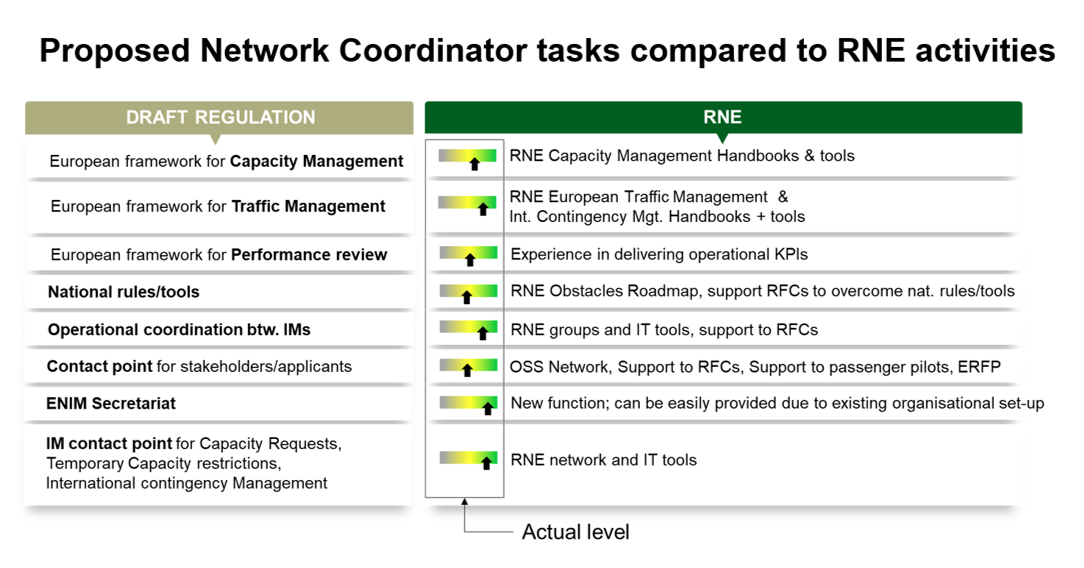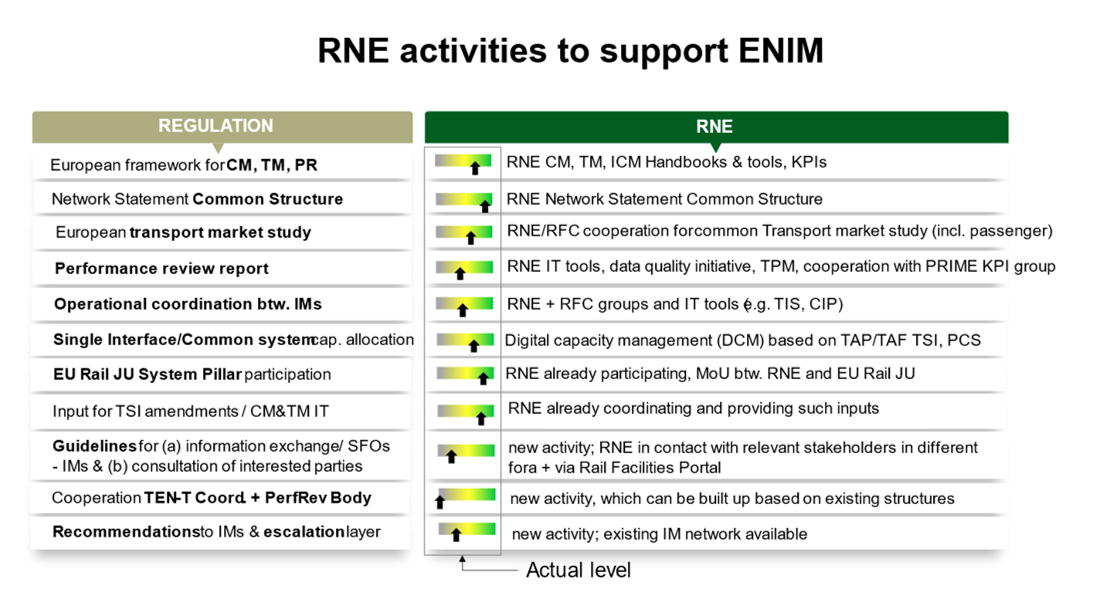RNE’s readiness to perform functions of network coordinator

- Capacity and traffic management processes, infrastructure information documents and IT tools reflected in the draft regulation were developed under the umbrella of RNE (without legal requirement, with a view to better serving market needs), including in particular in the following programmes
- TTR programme for capacity management (https://rne.eu/capacity-management/ttr/)
- ETMN programme for traffic management (https://rne.eu/traffic-management/etmn/)
- Language Programme (https://rne.eu/traffic-management/language-programme/)
- Incident management (https://rne.eu/traffic-management/incident-management/)
- Network Statement Common Structure (https://rne.eu/organisation/network-statements/)
- Digital capacity management (https://rne.eu/it/rne-it-strategy/digital-capacity-management/)
- Numerous RNE Handbooks and Guidelines are already available to serve as basis for setting up the European Frameworks for capacity and traffic management (https://rne.eu/downloads/). Additional work on socio-economic allocation principles and Commercial Conditions (”Compensations”) is ongoing at the level of RNE (in cooperation with other sector stakeholders).
- RNE has a fully functioning structure, with an office composed of approximately 60 employees from more than 20 different countries, most of them experts in the fields of capacity management, traffic management and IT. They work in close cooperation with experts from Infrastructure Managers on implementing many of the processes proposed in the draft Regulation (examples: 16 IMs already publish capacity strategies and 12 of these IMs already anticipate additional elements of the new capacity management process under coordination of RNE) and support operational coordination of IMs.
- RNE’s decision making structure allows all its Member IMs and allocation bodies to be involved in the development of harmonized processes and tools and the endorsement via various Groups (Working groups, high level groups, General Assembly), which helps to create commitment. The progress made in past years shows the willingness of RNE’s Members to jointly develop and implement European solutions via RNE.
- RNE is already involving a broad range of stakeholders in its work, via regular consultation on the basis of exchange and collaboration with associations such as FTE, ERFA, AllRail, CER, EIM, CIT, UIC, UIRR, RailFreightForward, IRG Rail.
- RNE combines development of harmonized business processes and IT tools under one roof; examples: Traffic Management Tool TIS, Capacity Booking Coordination Tool PCS. RNE is already closely working with EU Rail Joint undertaking and ERA on digital tool developments and harmonized IT architecture, avoiding double work and respecting responsibilities of the respective entities.
considerations on proposal to create new entity ERICA
- The European Rail International Capacity Allocation body (ERICA) is an additional body, which adds a further layer of complexity. Its composition and set-up are unclear.
- It disregards the fact that many of functions of network coordinator are today already successfully performed by RNE with a wide network of experts and know how built up over two decades.
- According to Directive 2012/34, path allocation is an essential function of each infrastructure manager. The draft regulation is entirely based upon this logic and merely focuses on obliging IMs to better coordinate and harmonize across borders. ERICA would thus be inconsistent with the logic of distribution of roles under Directive 2012/34.
- A transfer of functions to ERICA would bring significant transition costs.
- Such new entity cannot be set up in due time to prepare important documents that are a prerequisite for implementing the rules on capacity and traffic management for Timetable 2030 the latest. Preparation for implementation of the draft Regulation effectively needs to start immediately (i.e. today), if timelines of draft Regulation shall be met (or even anticipated). ERICA would slow down implementation of the new capacity and traffic management processes, while RNE is already working on it today.
- Key parts of the draft Regulation are based on processes developed by the sector under the umbrella of RNE; bringing in a completely new entity could lead to consistency issues.
Comparison of scope of RNE activities and functions of network coordinator / possible areas of support to ENIM


Find key information about the Network Coordinator project on our dedicated website, which serves as a central hub.